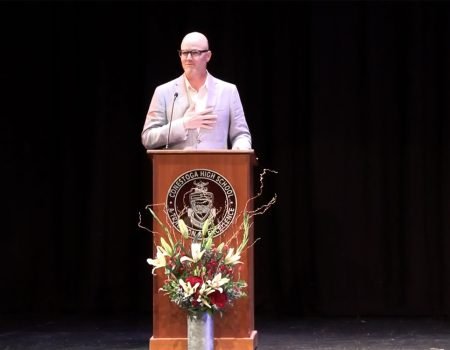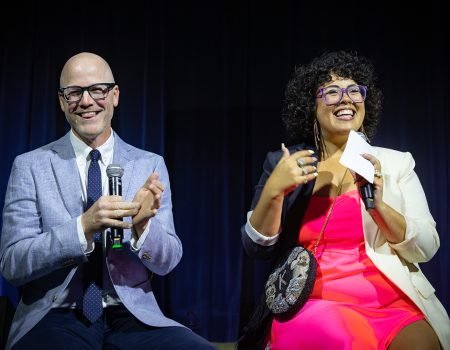Executive Summary
What follows is an email I sent the entire news department yesterday summarizing the conference last week (thereby making it, quite literally, an “executive summary”). I think it was kinda’ radical to send from within the Big Media firewall. So I thought you might like to read it.
Last week’s OnHollywood conference brought Silicon Valley entrepreneurs, venture capitalists, and traditional media together to discuss (and make deals around) the ongoing “new media” mashup (that is, the post YouTubeGoogleMySpace world). The three-day confab consisted primarily of expert panels and CEO presentations from some of the top thinkers in the space. Here’s some light weekend reading based on my learnings there:
TOP LINE SUMMARY:
1- A “tsunami” of video is headed for the Internet as Big Media embraces the burgeoning paradigm shift. Numerous entrepreneurial start-ups are scrambling to find ways to intelligently aggregate that video, enable community around niche interests, and customized domains.
2- Appointment viewing has been replaced by time shifting (Tivo) which has been replaced by place shifting (Slingbox). In other words, our audience expects what they want, when they want it, wherever they are.
3- Forget brand loyalty. The “IM Generation” is not a “Coke vs. Pepsi” generation; they grew up with 200 brands of water from which to choose. For them, media and technology choices create social currency (or, as Rob Gordon says in “High Fidelity,” “You are what you like.”)
4- Mobile is fast becoming a media gateway. Today, 32 mobile phones are sold every second. By 2009, mobile sales will outpace PC sales 3:1.
KEYNOTE/PANEL NOTES:
Slingbox CEO Blake Krikorkian: “With the democratization of production tools and distribution, the days of the single studio [or network] are finally starting to break down. So in the old days where you had basically the content and the distributor and three ways get programming — cable, satellite, and DVD — now, the fact is, if a producer can aggregate a million or two customers around the world — because there are no boundaries and the cost of distribution is so low — you have a whole new economy. So every day that [Big media] doesn’t embrace [the 2.0 paradigm shift] they’re giving up ground to this huge tidal wave of incredible producers who are creating their own content.”
Digg CEO Kevin Rose: “Every time you Digg we learn a little more about you so we can suggest stories and people to you that you might want to know more about.”
“[If I were the head of a major network] I would allow the user come in and have a voice and service content, and I would allow the community to interact with each other, and the network.”
TMZ CEO Alan Citron: “Things have changed. And the fact is, [Big Media] has to embrace these changes. As an example, it was a Friday night when the Mel Gibson story broke. When I woke up Saturday morning it occurred to me that it might not get noticed. So I called my old media friends [at Variety and LA Times], and the initial resistance was incredible! They said things like, ‘How can it have happened if you reported it?’ and ‘If it was reported on the Internet it must not be true!’ But by Sunday everyone was reporting it. So Big Media has to go through a series of steps before its comfortable, but it’s inevitable that content will be in many places, and that users will determine it.”
Intelligent Group Trendspotter Tristan Coopersmith: “[The ‘IM generation’] is the ‘I want what I want and I want it when I want it’ generation. Their whole lives are documented. None of their life is by appointment. They want customization, and self-expression. The choices they make are a representation of who they are — social currency. And they have no brand loyalty. This is not a Coke or Pepsi generation. They grew up with 200 brands of water!”
“So [what we’re finding with the ‘IM Generation’ is that] My Space isn’t exclusionary enough. So we hear them using terms like “My Space suicide” and “downsizing friends.” Young people want niche sites based on psychographics, not just demographic. So sites for high school football players, pet lovers — whatever.”
Motorola CTO Padmasree Warrior: “Mobile phones are becoming personal media gateway; they’re dedicated, personalized, always on, and always with you. So what we’re seeing is a shift from planned production to spontaneous generation, from broadcasting to personacasting, and from appointment viewing to placeshifting.”
RANDOM RAW DATA:
* 20M video streams: FunnyOrDie’s first six days (also, YouTube’s first six months)
* 30M Wii, PS3 and XBoxes in American homes by 2008.
* 25B media-related video streams served in 2006: 35% music video, 25% news.
* 25% of online newspaper traffic is driven by search.
* 45% of Europeans watch TV shows online.
* 55% of online video (some 44B streams) will be user generated by 2010.
* 60% of that which teenagers currently view online (video, photos and text) was created by someone they know.
* 99% of all video hasn’t even been digitized yet.
NEW PRODUCT DEMOS:
www.me.tv – program and share your own personalized channel (ex: www.carsondaly.tv) from your own videos, and your favorites from around the web.
www.kyte.tv – shoot and produce shows on you mobile phone.
www.cozmo.tv – like Last FM for video.
www.ontour.net – dynamic multiplatform tour date app.
www.freemp3.net – rights-free, share-enabled downloads.
www.movenetworks.com – hi-res broadband network.
www.swarmcast.com – multisource HD network.
www.kliptronic.com – integrated, dynamic, multiplatform ad serving.
RESOURCES FOR “NEW MEDIA” NEWS:
www.lostremote.com
www.paidcontent.com
www.newteevee.com
www.longtail.com
www.beet.tv
www.alwayson.goingon.com



